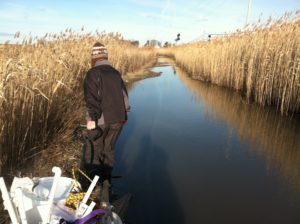Boston Harbor Ecosystem Network
 The Boston Harbor Ecosystem Network (formerly Boston Harbor Habitat Coalition) is comprised of individuals and organizations with interest in protecting, restoring, and educating the public about estuarine resources within the Metro Boston region of the MassBays National Estuary Partnership.
The Boston Harbor Ecosystem Network (formerly Boston Harbor Habitat Coalition) is comprised of individuals and organizations with interest in protecting, restoring, and educating the public about estuarine resources within the Metro Boston region of the MassBays National Estuary Partnership.
Initiated in 2011 as the Boston Harbor Habitat Coalition, it changed its name in 2016 to reflect the interests and priorities of participating stakeholders. Participants may be unaffiliated individuals or may represent local, state, and federal agencies, watershed and community groups, academic institutions, informal science education centers, the private sector, and citizen science efforts. All are welcome to attend and participate in BHEN meetings and events.
The BHEN meets twice a year to learn about and discuss Network and other related projects, to network with others, and to learn from experts and practitioners about best practices in estuary health and management. To subscribe to the BHEN e-newsletter, click here.
Metro Boston Watersheds and Habitats
According to the Massachusetts Bays Program Estuary Delineation and Assessment Report (Geosyntec, 2017), there are eight watersheds delineated in the MassBays Metro Boston region, which stretches from Revere to Hull. They are:
 Saugus River/Pines River/Lynn Harbor
Saugus River/Pines River/Lynn Harbor- Belle Isle Creek/Winthrop Bay
- Chelsea Creek/Mystic River/Charles River/Boston Inner Harbor
- Neponset River/Dorchester Bay
- Blacks Creek/Quincy Bay
- Back River/Fore River/Hingham Bay
- Weir River/Straits Pond
- Boston Harbor
The Boston Harbor Habitat Atlas, an interactive online tool currently undergoing updates, characterizes eight habitats for the region: rocky shores, salt marshes, sandy beaches, seagrass beds, intertidal flats, shellfish beds, migratory fishways, and the fouling community on human-made structures. Access to relevant Metro Boston layers for these habitats are accessible via the Massachusetts Ocean Resource Information System (MORIS), which is produced by the Massachusetts Office of Coastal Zone Management.
A number of factors are negatively impacting these habitats, many of which are human-induced and directly related to the urbanized nature of the region. Some of these stressors are high intensity land use, extent of impervious cover, stormwater and wastewater discharges, tidal restrictions, barriers to fish passage, arrival and spread of invasive species, and extreme weather events.